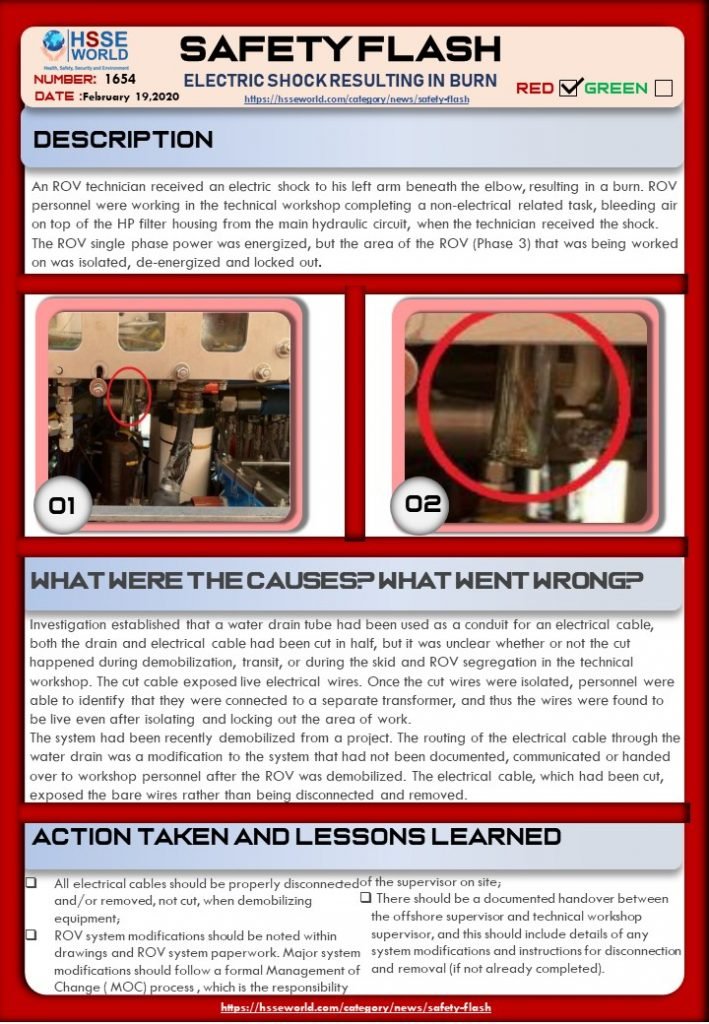Safety Flash: Electric Shock Resulting in Burn
3 min readWhat happened?
An ROV technician received an electric shock to his left arm beneath the elbow, resulting in a burn. ROV personnel were working in the technical workshop completing a non-electrical related task, bleeding air on top of the HP filter housing from the main hydraulic circuit, when the technician received the shock. The ROV single-phase power was energized, but the area of the ROV (Phase 3) that was being worked on was isolated, de-energized, and locked out.


What were the causes? What went wrong?
The investigation established that a water drain tube had been used as a conduit for an electrical cable, both the drain and electrical cable had been cut in half, but it was unclear whether or not the cut happened during demobilization, transit, or during the skid and ROV segregation in the technical workshop. The cut cable exposed live electrical wires. Once the cut wires were isolated, personnel were able to identify that they were connected to a separate transformer, and thus the wires were found to be live even after isolating and locking out the area of work.
The system had been recently demobilized from a project. The routing of the electrical cable through the water drain was a modification to the system that had not been documented, communicated, or handed over to workshop personnel after the ROV was demobilized. The electrical cable, which had been cut, exposed the bare wires rather than being disconnected and removed.
What Actions were taken & lessons learned?
- All electrical cables should be properly disconnected and/or removed, not cut when demobilizing equipment;
- ROV system modifications should be noted within drawings and ROV system paperwork. Major system modifications should follow the formal management of change (MoC) process, which is the responsibility of the supervisor on-site;
- There should be a documented handover between the offshore supervisor and technical workshop supervisor, and this should include details of any system modifications and instructions for disconnection and removal (if not already completed).


These flashes summarise key safety matters and incidents, allowing wider dissemination of lessons learned from them. The information below has been provided in good faith by members and should be reviewed individually by recipients, who will determine its relevance to their own operations. The effectiveness of the safety flash system depends on receiving reports from members in order to pass on the information and avoid repeat incidents.
Source and download
| Alert ID: | 1654 |
| Published: | February 19,2020 |
| Download: | Safety flash (322 kB) |
Read More Safety Flash
- Safety Flash: Mobile concrete placing boom overturn incidents
- Safety Flash: Not Following Work permit and Isolation Procedure
- Safety Flash: Floorman arm pinned by Pipe Handling Equipment
- Safety Flash: Suspension Trauma
- Safety Flash: Fatality: explosive failure of corroded fire extinguisher
- Safety Flash: Crewman fell to his death through faulty grating
- Safety Flash: Fatal accident during cargo operations on Karina C
- Safety Flash: Overturning of the Lifeboat Kristin Faye
- Safety Flash: Short circuit on 440v AC bus bars-arc flash
- Safety Flash: Towing Fatality
- Safety Flash: Unsafe lifting operations
- Safety Flash: Electric Shock Resulting in Burn
- Safety Flash: LTI- Loss of Finger Tip and Nail
- Safety Flash: Explosion And Fire Onboard The chemical Tanker STOLT Greenland
- Safety Flash: Finger injury caused by incorrectly secured console cover
- Safety Flash: double Man overboard Resulting in one fatality
- Safety Flash: Alcohol-based hand sanitizer warning
- Safety Flash: Dump truck operator fatally electrocuted by high-voltage line
- Safety Flash: Laborer Dies After Footing Collapse – North Carolina
- Safety Flash: Reducing the risk of propane explosions in food trucks
- Safety Flash: Teen Roofer Electrocuted when Ladder Contacts High Voltage Power Line
- Safety Flash: Worker dies from carbon monoxide poisoning while using pressure washer
- Safety Flash: Explosion during welding operation
- A Bathtub Refinisher Dies from Methylene Chloride Exposure :Safety Flash
- Landscaper dies after auger entanglement:Safety Flash
- Worker dies after falling from scaffold
- Fatality Investigation: Orchard Worker Dies After Falling Off Tractor
- LTI: Fall from height leading to Multiple Fractures
- Operator dies when forklift falls off loading dock
- Worker struck, killed by outrigger
- Worker killed by platform
- Scaffolding Components
- Construction Worker Killed When Pipe Rolls Off a Trailer
- Near-Miss: Shackle Configuration
- Improper use of lifeline results in death of worker



